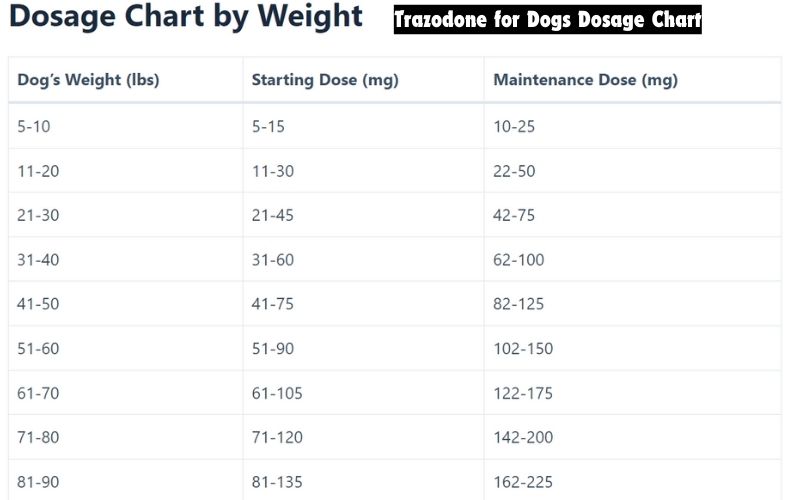When it comes to our furry friends, their mental health is just as important as their physical well-being. Anxiety, stress, and various behavioral issues can significantly impact a dog’s quality of life. One medication that veterinarians often prescribe to help manage these conditions is trazodone. In this comprehensive guide, we’ll explore everything you need to know about trazodone for dogs, including its uses, benefits, side effects, and a detailed dosage chart to help you administer it safely.
What is Trazodone?
Trazodone is a prescription medication primarily used to treat depression and anxiety in humans. However, it is also commonly prescribed by veterinarians to manage anxiety, stress, and certain behavioral issues in dogs. It belongs to a class of drugs known as serotonin receptor antagonists and reuptake inhibitors (SARIs). By increasing serotonin levels in the brain, trazodone helps to improve mood and reduce anxiety.
Uses of Trazodone in Dogs
Trazodone is versatile in its applications for dogs. Some of the common uses include:
- Anxiety Relief: Trazodone is often prescribed to dogs suffering from various forms of anxiety, including separation anxiety, noise phobia, and general anxiety.
- Post-Surgical Sedation: After surgery, dogs may experience stress and agitation. Trazodone can help keep them calm during their recovery period.
- Travel Anxiety: Many dogs experience anxiety during car rides or other forms of travel. Trazodone can help make these experiences more manageable for both the dog and the owner.
- Behavioral Issues: For dogs exhibiting behavioral problems such as aggression, compulsive behaviors, or excessive barking, trazodone can be part of a comprehensive behavior modification plan.
- Veterinary Visits: Some dogs experience significant stress during visits to the veterinarian. Administering trazodone prior to the visit can help reduce anxiety and make the experience less traumatic.
- Fireworks and Thunderstorms: Loud noises from fireworks and thunderstorms can trigger intense anxiety in some dogs. Trazodone can help keep them calm during these events.
- Confinement Anxiety: Dogs that need to be confined, such as during crate training or boarding, may benefit from trazodone to ease their anxiety.
Benefits of Trazodone for Dogs
- Calming Effect: Trazodone helps to reduce anxiety and stress, making it easier for dogs to cope with challenging situations.
- Non-Sedative: Unlike some other medications, trazodone does not typically cause significant sedation, allowing dogs to remain alert and active.
- Versatility: It can be used for both short-term and long-term management of anxiety and behavioral issues.
- Complementary Therapy: Trazodone can be used in combination with other medications and behavior modification techniques for a more comprehensive approach to treatment.
- Improved Quality of Life: By managing anxiety and stress, trazodone can enhance a dog’s overall quality of life, making them happier and healthier.
- Ease of Administration: Trazodone is available in various forms, including tablets and liquid formulations, making it easier to administer to dogs of different sizes and preferences.
Potential Side Effects
While trazodone is generally well-tolerated by dogs, it is essential to be aware of potential side effects. Some common side effects include:
- Gastrointestinal Upset: Vomiting and diarrhea can occur, especially when first starting the medication. Administering trazodone with food can help mitigate these effects.
- Drowsiness: Some dogs may experience mild sedation or drowsiness, particularly at higher doses.
- Incoordination: Occasionally, dogs may exhibit unsteadiness or a lack of coordination.
- Increased Excitability: Paradoxically, some dogs may become more anxious or agitated when taking trazodone.
- Panting: Increased panting is another potential side effect to be aware of.
- Changes in Appetite: Some dogs may experience changes in appetite, either an increase or decrease, while taking trazodone.
- Lethargy: Some dogs may become more lethargic or less active than usual.
If you notice any severe or persistent side effects, contact your veterinarian immediately. They may adjust the dosage or recommend an alternative treatment.
Trazodone Dosage Chart for Dogs
Determining the correct dosage of trazodone for your dog is crucial for ensuring its effectiveness and safety. The dosage depends on several factors, including the dog’s weight, age, overall health, and the severity of the condition being treated. Below is a general dosage chart, but it’s essential to follow your veterinarian’s recommendations for your specific pet.
General Dosage Guidelines
- Starting Dose: The initial dose of trazodone typically ranges from 1 to 3 mg per pound of body weight per day. This dose can be gradually increased based on the dog’s response and tolerance.
- Maintenance Dose: The maintenance dose usually ranges from 2 to 5 mg per pound of body weight per day, divided into two doses.
Dosage Chart by Weight
| Dog’s Weight (lbs) | Starting Dose (mg) | Maintenance Dose (mg) |
|---|---|---|
| 5-10 | 5-15 | 10-25 |
| 11-20 | 11-30 | 22-50 |
| 21-30 | 21-45 | 42-75 |
| 31-40 | 31-60 | 62-100 |
| 41-50 | 41-75 | 82-125 |
| 51-60 | 51-90 | 102-150 |
| 61-70 | 61-105 | 122-175 |
| 71-80 | 71-120 | 142-200 |
| 81-90 | 81-135 | 162-225 |
| 91-100 | 91-150 | 182-250 |
Administration Tips
- With Food: Administer trazodone with food to reduce the risk of gastrointestinal upset.
- Divided Doses: If your veterinarian prescribes a higher dose, it’s often divided into two or more doses throughout the day.
- Gradual Adjustment: Start with the lower end of the dosage range and gradually increase the dose as needed, under the guidance of your veterinarian.
Monitoring and Adjusting Dosage
Close monitoring is crucial when your dog starts trazodone. Here are some steps to follow:
- Observe Your Dog: Watch for any side effects or changes in behavior, both positive and negative.
- Keep a Journal: Maintain a record of your dog’s dosage, administration times, and any observed effects.
- Communicate with Your Vet: Regularly update your veterinarian on your dog’s progress. They may need to adjust the dosage based on your observations.
- Periodic Check-ups: Schedule periodic check-ups with your veterinarian to assess your dog’s response to the medication and make any necessary adjustments.
Case Studies and Real-Life Examples
Case Study 1: Managing Separation Anxiety
Background: Bella, a 5-year-old Labrador Retriever, exhibited severe separation anxiety. She would become highly agitated and destructive when left alone.
Treatment Plan: Bella’s veterinarian prescribed trazodone, starting at 2 mg per pound of body weight per day. Her owner gradually increased the dose to 4 mg per pound, divided into two doses.
Outcome: Within two weeks, Bella showed significant improvement. She remained calm when left alone and her destructive behaviors diminished.
Case Study 2: Post-Surgical Sedation
Background: Max, a 7-year-old German Shepherd, underwent knee surgery. Post-surgery, he was restless and agitated, hindering his recovery.
Treatment Plan: Max was prescribed trazodone at 3 mg per pound of body weight per day to help keep him calm during his recovery period.
Outcome: Max responded well to the medication, allowing him to rest and heal properly. His veterinarian gradually tapered off the medication as he recovered.
Case Study 3: Travel Anxiety
Background: Daisy, a 3-year-old Beagle, experienced severe anxiety during car rides, making travel stressful for her and her owner.
Treatment Plan: Daisy’s veterinarian recommended trazodone at 2 mg per pound of body weight, administered 1-2 hours before travel.
Outcome: Daisy’s anxiety levels decreased significantly during car rides, making travel more manageable.
Case Study 4: Noise Phobia
Background: Rocky, a 4-year-old Border Collie, exhibited extreme fear and anxiety during thunderstorms and fireworks.
Treatment Plan: Rocky’s veterinarian prescribed trazodone at 2.5 mg per pound of body weight, to be administered 1 hour before the anticipated noise event.
Outcome: Rocky became noticeably calmer during thunderstorms and fireworks, reducing his anxiety and stress.
Case Study 5: Behavioral Issues
Background: Luna, a 2-year-old Boxer, displayed aggressive behavior towards other dogs and strangers.
Treatment Plan: In combination with behavior modification training, Luna was prescribed trazodone at 3 mg per pound of body weight per day, divided into two doses.
Outcome: Over several months, Luna’s aggressive behavior improved significantly, and she became more manageable around other dogs and people.
Combining Trazodone with Other Treatments
For many dogs, trazodone is most effective when used as part of a comprehensive treatment plan that includes behavior modification techniques and other medications. Here are some examples of combined treatments:
- Behavior Modification: Work with a professional dog trainer or behaviorist to address the root causes of anxiety and behavioral issues. Techniques may include desensitization, counter-conditioning, and positive reinforcement.
- Other Medications: In some cases, trazodone may be used alongside other anti-anxiety medications or supplements, such as SSRIs (Selective Serotonin Reuptake Inhibitors), benzodiazepines, or natural remedies like CBD oil and calming supplements.
- Environmental Changes: Implement changes in the dog’s environment to reduce stress, such as providing a quiet space, using calming music, or applying pressure wraps like the Thundershirt.
- Routine and Structure: Establish a consistent daily routine for your dog to provide a sense of security and predictability.
- Exercise and Enrichment: Regular physical exercise and mental stimulation can help reduce anxiety and improve overall behavior. Activities like puzzle toys, obedience training, and interactive play can be beneficial.
See Also: How Much Zyrtec for Dogs
Precautions and Contraindications
While trazodone is generally safe for dogs, there are certain precautions and contraindications to keep in mind:
- Medical History: Inform your veterinarian of your dog’s complete medical history, including any other medications or supplements they are taking.
- Pre-existing Conditions: Use caution when administering trazodone to dogs with liver, kidney, or heart conditions.
- Pregnancy and Lactation: The safety of trazodone in pregnant or lactating dogs has not been well-studied, so it should be used with caution.
- Allergic Reactions: Watch for signs of an allergic reaction, such as swelling, hives, or difficulty breathing, and seek veterinary attention immediately if they occur.
- Drug Interactions: Trazodone can interact with other medications, such as MAO inhibitors, so it’s essential to inform your veterinarian about all drugs your dog is taking.
Frequently Asked Questions (FAQs)
1. How long does it take for trazodone to work in dogs?
The onset of action for trazodone can vary, but most dogs start to show a response within 1 to 2 hours after administration. The full effects may take a few days to become apparent, especially if the dosage is being gradually increased.
2. Can I use trazodone for long-term treatment in dogs?
Yes, trazodone can be used for both short-term and long-term treatment of anxiety and behavioral issues in dogs. However, long-term use should be closely monitored by a veterinarian to ensure it remains effective and safe.
3. What should I do if I miss a dose?
If you miss a dose of trazodone, give it as soon as you remember. If it’s close to the time for the next dose, skip the missed dose and resume the regular dosing schedule. Do not double up on doses.
4. Can trazodone be used in combination with other anxiety medications?
Yes, trazodone can be used in combination with other anxiety medications or supplements. However, this should only be done under the guidance of a veterinarian to avoid potential drug interactions and ensure safety.
5. How should I store trazodone?
Store trazodone at room temperature, away from moisture and heat. Keep it out of reach of children and pets to prevent accidental ingestion.
6. Can trazodone cause withdrawal symptoms in dogs?
While trazodone is not typically associated with withdrawal symptoms, it’s essential to follow your veterinarian’s instructions when discontinuing the medication. Gradual tapering may be recommended to prevent any potential issues.
Conclusion
Trazodone can be a valuable tool in managing anxiety, stress, and behavioral issues in dogs. By understanding its uses, benefits, potential side effects, and proper dosage, pet owners can ensure their furry friends receive the best possible care. Always work closely with your veterinarian to tailor the treatment plan to your dog’s specific needs and monitor their progress closely.
By following the guidelines outlined in this article, you can help your dog lead a happier, calmer, and more comfortable life. Whether it’s managing separation anxiety, aiding in post-surgical recovery, or making travel less stressful, trazodone can play a crucial role in improving your dog’s overall well-being. Remember that every dog is unique, and what works for one may not work for another. Patience, observation, and open communication with your veterinarian are key to finding the most effective treatment plan for your beloved pet.




